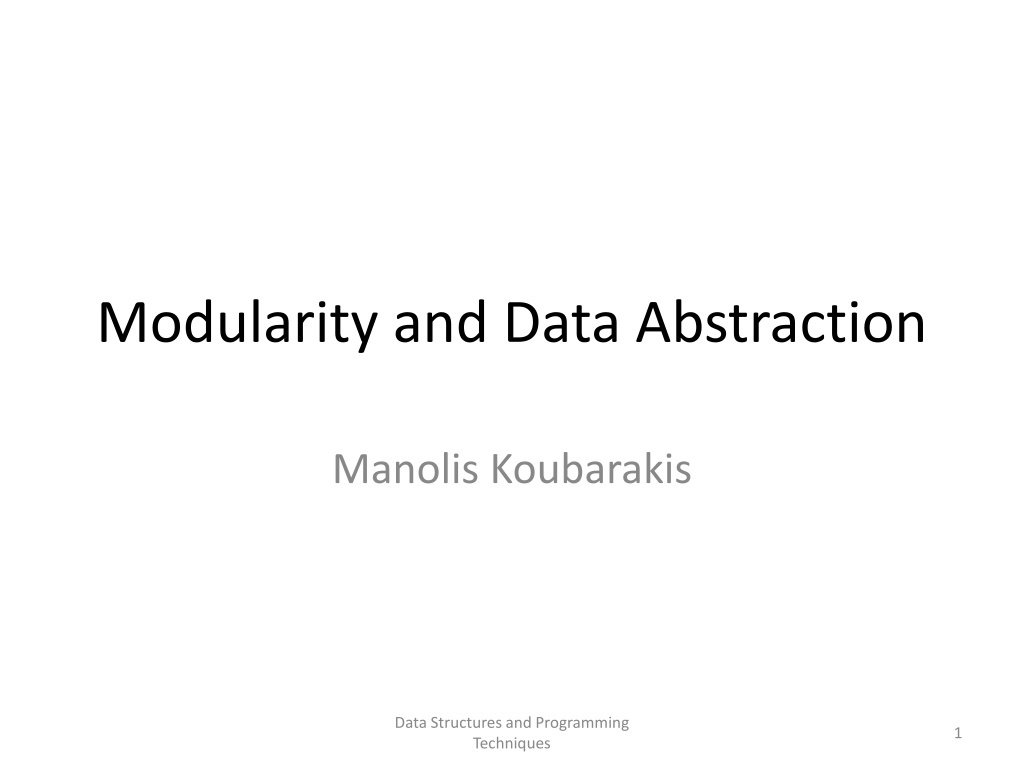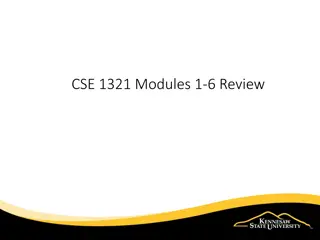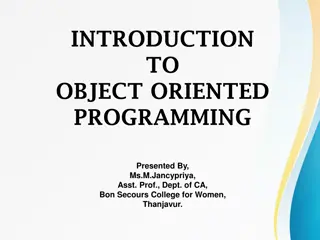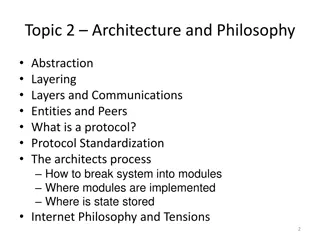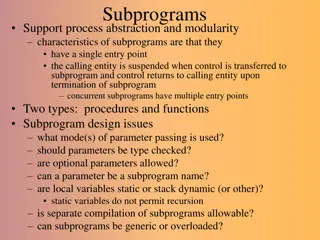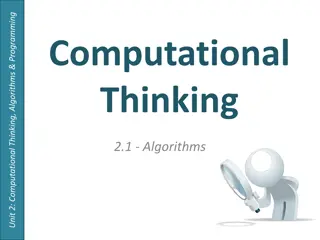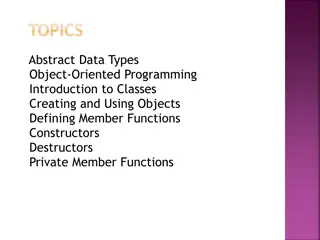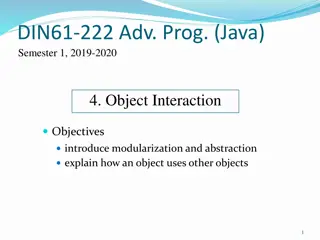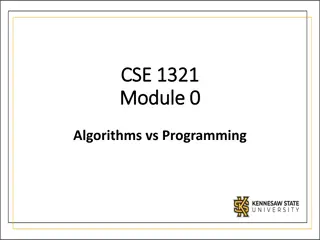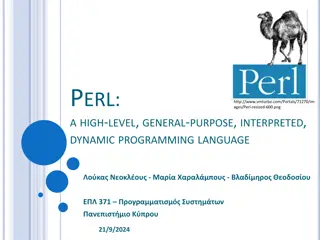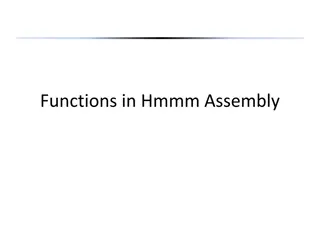Understanding Modularity and Data Abstraction in Programming
Learn about the importance of procedural abstraction, information hiding, modules, and abstract datatypes in programming. Discover how these concepts help in structuring large programs, improving maintainability, and enhancing data organization and operation control.
Download Presentation

Please find below an Image/Link to download the presentation.
The content on the website is provided AS IS for your information and personal use only. It may not be sold, licensed, or shared on other websites without obtaining consent from the author. Download presentation by click this link. If you encounter any issues during the download, it is possible that the publisher has removed the file from their server.
E N D
Presentation Transcript
Modularity and Data Abstraction Manolis Koubarakis Data Structures and Programming Techniques 1
Procedural Abstraction When programs get large, certain disciplines of structuring need to be followed rigorously. Otherwise, the programs become complex, confusing and hard to debug. In your first programming course you learned the benefits of procedural abstraction ( ). When we organize a sequence of instructions into a function F(x1, , xn), we have a named unit of action. When we later on use this function F, we only need to know what the function does, not how it does it. Data Structures and Programming Techniques 2
Procedural Abstraction (contd) Separating the what from the how is an act of abstraction ( ). It provides two benefits: Ease of use Ease of modification Data Structures and Programming Techniques 3
Information Hiding In your first programming course, you have also learned the benefits of having locally defined variables. This is an instance of information hiding ( ). It has the advantage that local variables do not interfere with identically named variables outside the function. Abstraction and information hiding in a programming language are greatly enhanced with the concept of module ( ). Data Structures and Programming Techniques 4
Modules and Abstract Datatypes A module is a unit of organization of a software system that packages together a collection of entities (such as data and operations) and that carefully controls what external users of the module can see and use. Modules have ways of hiding things inside their boundaries to prevent external users from accessing them. This is called information hiding. Abstract data types ( , ADTs) are collections of objects and operations that present well defined interfaces ( ) to their users, meanwhile hiding the way they are represented in terms of lower-level representations. Modules can be used to implement abstract data types. Data Structures and Programming Techniques 5
Modules (contd) Many modern programming languages offer modules that have the following important features: They provide a way of grouping together related data and operations. They provide clean, well-defined interfaces to users of their services. They hide internal details of operation to prevent interference. They can be separately compiled. Data Structures and Programming Techniques 6
Modules (contd) Modules are an important tool for dividing and conquering a large software task by combining separate components that interact cleanly. They ease software maintenance ( )by allowing changes to be made locally. Data Structures and Programming Techniques 7
Encapsulation When we have features like modules in programming languages, we use the term encapsulation ( , the hidden local entities are encapsulated and a module is a capsule). Data Structures and Programming Techniques 8
Modules in C By means of careful use of header files, we can arrange for separately compiled C program files to have the above four properties of modules. In this way C modules are similar to packages or modules in other languages such as Modula-2 and Ada. Data Structures and Programming Techniques 9
Modules in C (contd) A C module M consists of two files MInterface.h and MImplementation.c that are organized as follows. The file Minterface.h: /*------<the text for the file MInterface.h starts here>---------- */ (declarations of entities visible to external users of the module) /*--------------<end of file MInterface.h>-------------------------*/ Data Structures and Programming Techniques 10
Modules in C (contd) The file MImplementation.c: /*-------<the text for the file Mimplementation.c starts here>------*/ #include <stdio.h> #include MInterface.h (declarations of entities private to the module plus the) (complete declarations of functions exposed by the module) /*---------------<end of file MImplementation.c>--------------------*/ Data Structures and Programming Techniques 11
The Interface file MInterface.h is the interface file. It declares all the entities in the module that are visible to (and therefore usable by) the external users of the module. Such visible entities include constants, typedefs, variables and functions. Only the prototype of each visible function is given (and only the argument types, not the argument names). The book by Standish recommends that declarations of functions in the interface file are extern declarations. This is not necessary so we will not follow it. Data Structures and Programming Techniques 12
The Implementation File MImplementation.c is the implementation file. It contains all the private entities in the module, that are not visible to the outside. It contains the full declarations and implementations of functions whose prototypes have been given in the interface file. It includes (via #include) the user interface file. Data Structures and Programming Techniques 13
The Main Program A main program (client program) that uses two modules A and B is organized as follows: #include <stdio.h> #include ModuleAInterface.h #include ModuleBInterface.h (declarations of entities used by the main program) int main(void) { (statements to execute in the main program) } Data Structures and Programming Techniques 14
Separate Compilation We can compile the module and the client program separately: gcc -c MImplementation.c -o M.o gcc -c ClientProgram.c -o ClientProgram.o gcc M.o ClientProgram.o o ClientProgram.exe With the first two commands, we compile the C files to produce object files. Then, the object files are linked to produce the final executable. Data Structures and Programming Techniques 15
Priority Queues An Abstract Data Type A priority queue is a container that holds some prioritized items. For example, a list of jobs with a deadline for processing each one of them. When we remove an item from a priority queue, we always get the item with highest priority. Data Structures and Programming Techniques 16
Defining the ADT Priority Queue A priority queue is a finite collection of items for which the following operations are defined: Initialize the priority queue, PQ, to the empty priority queue. Determine whether or not the priority queue, PQ, is empty. Determine whether or not the priority queue, PQ, is full. Insert a new item, X, into the priority queue, PQ. If PQ is non-empty, remove from PQ an item X of highest priority in PQ. Data Structures and Programming Techniques 17
A Priority Queue Interface File /* this is the file PQInterface.h */ #include PQTypes.h /* defines types PQItem and PriorityQueue */ void Initialize (PriorityQueue *); int Empty (PriorityQueue *); int Full (PriorityQueue *); void Insert (PQItem, PriorityQueue *); PQItem Remove (PriorityQueue *); Data Structures and Programming Techniques 18
Sorting Using a Priority Queue Let us now define an array A to hold ten items of type PQItem, where PQItems have been defined to be integer values, such that bigger integers have greater priority than smaller ones: typedef int PQItem; typedef PQItem SortingArray[10]; SortingArray A; We can now use a priority queue to sort the array A. We can successfully use the ADT priority queue whose interface was given earlier without having to know any details of its implementation. Data Structures and Programming Techniques 19
Sorting Using a Priority Queue (contd) /* this is the main program */ #include <stdio.h> #include PQInterface.h typedef PQItem SortingArray[MAXCOUNT]; /* Note: MAXCOUNT is 10 */ void PriorityQueueSort(SortingArray A) { int i; PriorityQueue PQ; Initialize(&PQ); for (i=0; i<MAXCOUNT; ++i) Insert(A[i], &PQ); for (i=MAXCOUNT-1; i>=0; --i) A[i]=Remove(&PQ); } Data Structures and Programming Techniques 20
Sorting Using a Priority Queue (contd) int SquareOf(int x) { return x*x; } int main(void) { int i; SortingArray A; for (i=0; i<10; ++i){ A[i]=SquareOf(3*i-13); printf( %d ,A[i]); } printf( \n ); PriorityQueueSort(A); for (i=0; i<10; ++i) { printf( %d ,A[i]); } printf( \n ); return 0; } Data Structures and Programming Techniques 21
Implementations of Priority Queues We will present two implementations of a priority queue: Using sorted linked lists Using unsorted arrays Data Structures and Programming Techniques 22
The Priority Queue Data Types In the sorted linked list case, the file PQTypes.h can be defined as follows: #define MAXCOUNT 10 typedef int PQItem; typedef struct PQNodeTag { PQItem NodeItem; struct PQNodeTag *Link; } PQListNode; typedef struct { int Count; PQListNode *ItemList; } PriorityQueue; Data Structures and Programming Techniques 23
Implementing Priority Queues Using Sorted Linked Lists /* This is the file PQImplementation.c */ #include <stdio.h> #include <stdlib.h> #include PQInterface.h /* Now we give all the details of the functions */ /* declared in the interface file together with */ /* local private functions. */ void Initialize(PriorityQueue *PQ) { PQ->Count=0; PQ->ItemList=NULL; } Data Structures and Programming Techniques 24
Implementing Priority Queues Using Sorted Linked Lists (cont d) int Empty(PriorityQueue *PQ) { return(PQ->Count==0); } int Full(PriorityQueue *PQ) { return(PQ->Count==MAXCOUNT); } Data Structures and Programming Techniques 25
Implementing Priority Queues Using Sorted Linked Lists (cont d) PQListNode *SortedInsert(PQItem Item, PQListNode *P) { PQListNode *N; if ((P==NULL)||(Item >=P->NodeItem)){ N=(PQListNode *)malloc(sizeof(PQListNode)); N->NodeItem=Item; N->Link=P; return(N); } else { P->Link=SortedInsert(Item, P->Link); return(P); } } Data Structures and Programming Techniques 26
Implementing Priority Queues Using Sorted Linked Lists (cont d) void Insert(PQItem Item, PriorityQueue *PQ) { if (!Full(PQ)){ PQ->Count++; PQ->ItemList=SortedInsert(Item, PQ->ItemList); } } Data Structures and Programming Techniques 27
Functions Insert and SortedInsert The function Insert keeps the elements of the list in decreasing order (the first item has the highest priority). The function Insert calls SortedInsert for doing the actual insertion. SortedInsert has three cases to consider: If the ItemList of PQ is empty. If the new item has priority greater than or equal the priority of the first item on ItemList. If the new item has priority less than that of the first item on ItemList. In this case the function is called recursively on the tail of the list. Data Structures and Programming Techniques 28
Implementing Priority Queues Using Sorted Linked Lists (cont d) PQItem Remove(PriorityQueue *PQ) { PQItem temp; if (!Empty(PQ)){ temp=PQ->ItemList->NodeItem; PQ->ItemList=PQ->ItemList->Link; PQ->Count--; return(temp); } } Data Structures and Programming Techniques 29
Function Remove The function Remove simply deletes the item in the first node of the linked list representing PQ (this is the item with highest priority) and returns the value of its field NodeItem. Data Structures and Programming Techniques 30
The Priority Queue Data Types In the unsorted array case, the file PQTypes.h can be defined as follows: #define MAXCOUNT 10 typedef int PQItem; typedef PQItem PQArray[MAXCOUNT]; typedef struct { int Count; PQArray ItemArray; } PriorityQueue; Data Structures and Programming Techniques 31
Implementing Priority Queues Using Unsorted Arrays /* This is the file PQImplementation.c */ #include <stdio.h> #include PQInterface.h /* Now we give all the details of the functions */ /* declared in the interface file together with */ /* local private functions. */ void Initialize(PriorityQueue *PQ) { PQ->Count=0; } Data Structures and Programming Techniques 32
Implementing Priority Queues Using Unsorted Arrays (cont d) int Empty(PriorityQueue *PQ) { return(PQ->Count==0); } int Full(PriorityQueue *PQ) { return(PQ->Count==MAXCOUNT); } Data Structures and Programming Techniques 33
Implementing Priority Queues Using Unsorted Arrays (cont d) void Insert(PQItem Item, PriorityQueue *PQ) { if (!Full(PQ)) { PQ->ItemArray[PQ->Count]=Item; PQ->Count++; } } Data Structures and Programming Techniques 34
Function Insert The function Insert simply appends the new item to the end of array ItemArray of PQ. Data Structures and Programming Techniques 35
Implementing Priority Queues Using Unsorted Arrays (cont d) PQItem Remove(PriorityQueue *PQ) { int i; int MaxIndex; PQItem MaxItem; if (!Empty(PQ)){ MaxItem=PQ->ItemArray[0]; MaxIndex=0; for (i=1; i<PQ->Count; ++i){ if (PQ->ItemArray[i] > MaxItem){ MaxItem=PQ->ItemArray[i]; MaxIndex=i; } } PQ->Count--; PQ->ItemArray[MaxIndex]=PQ->ItemArray[PQ->Count]; return(MaxItem); } } Data Structures and Programming Techniques 36
Function Remove In the function Remove, we first find the item with highest priority. Then, we save it in a temporary variable (MaxItem), we delete it from the array ItemArray and move the last item of the array to its position. Then, we return the item of the highest priority. Data Structures and Programming Techniques 37
Interface Header Files Note that the module interface header file PQInterface.h is included in two important but distinct places: At the beginning of the implementation files that define the hidden representation of the externally accessed module services. At the beginning of programs that need to gain access to the external module services defined in the interface file. Data Structures and Programming Techniques 38
Separate Compilation We can compile the module and the client program separately: gcc -c PQImplementation.c -o PQ.o gcc -c sorting.c -o sorting.o gcc PQ.o sorting.o o program.exe With the first two commands, we compile the C files to produce object files. Then, the object files are linked to produce the final executable. Data Structures and Programming Techniques 39
Information Hiding Revisited Let us revisit the sorting program we wrote earlier and consider the new printf statement. #include <stdio.h> #include PQInterface.h typedef PQItem SortingArray[MAXCOUNT]; /* Note: MAXCOUNT is 10 */ void PriorityQueueSort(SortingArray A) { int i; PriorityQueue PQ; Initialize(&PQ); for (i=0; i<MAXCOUNT; ++i) Insert(A[i], &PQ); printf( The queue contains %d elements\n ,PQ.Count); for (i=MAXCOUNT-1; i>=0; --i) A[i]=Remove(&PQ); } Data Structures and Programming Techniques 40
Information Hiding Revisited (contd) This printf statement accesses the Count field of the priority queue PQ. Therefore, the previous module organization has not achieved information hiding as nicely as we would want it. We can live with that deficiency or try to address it. How? Data Structures and Programming Techniques 41
Another Example: Complex Number Arithmetic A complex number is an expression ? + ?? where ? and ? are reals. ? is called the real part and ? the imaginary part. ? = 1 is the imaginary unit. It follows that ?2= 1. To multiply complex numbers, we follow the usual algebraic rules. Data Structures and Programming Techniques 42
Examples ? + ?? ? + ?? = ?? + ??? + ??? + ???2= ?? ?? + ?? + ?? ? 1 ? 1 ? = 1 ? ? + ?2= 2? (1 + ?)4= 4?2= 4 (1 + ?)8= 16 Dividing the two parts of the above equation by 16 = ( 2)8, we find that (1 ? 2)8= 1. 2+ Data Structures and Programming Techniques 43
Complex Roots of Unity In general, there are many complex numbers that evaluate to 1 when raised to a power. These are the complex roots of unity. For each ?, there are exactly ? complex numbers ? such that ??= 1. The numbers cos(2?? 0,1, ,? 1 can be easily shown to have this property. Let us now write a program that computes and outputs these numbers for a given ?. ?) + ?sin(2?? ?) for ? = Data Structures and Programming Techniques 44
An ADT for Complex Numbers: the Interface /* This is the file COMPLEX.h */ typedef struct complex *Complex; Complex COMPLEXinit(float, float); float Re(Complex); float Im(Complex); Complex COMPLEXmult(Complex, Complex); Data Structures and Programming Techniques 45
Notes The interface on the previous slide provides clients with handles to complex number objects but does not give any information about the representation. The representation is a struct that is not specified except for its tag name. Data Structures and Programming Techniques 46
Handles We use the term handle to describe a reference to an abstract object. Our goal is to give client programs handles to abstract objects that can be used in assignment statements and as arguments and return values of functions in the same way as built-in data types, while hiding the representation of objects from the client program. Data Structures and Programming Techniques 47
Complex Numbers ADT Implementation /* This is the file CImplementation.c */ #include <stdlib.h> #include "COMPLEX.h" struct complex { float Re; float Im; }; Complex COMPLEXinit(float Re, float Im) { Complex t = malloc(sizeof *t); t->Re = Re; t->Im = Im; return t; } float Re(Complex z) { return z->Re; } float Im(Complex z) { return z->Im; } Complex COMPLEXmult(Complex a, Complex b) { return COMPLEXinit(Re(a)*Re(b) - Im(a)*Im(b), Re(a)*Im(b) + Im(a)*Re(b)); } Data Structures and Programming Techniques 48
Notes The implementation of the interface in the previous program includes the definition of structure complex(which is hidden from the clients) as well as the implementationof the functions provided by the interface. Objects are pointers to structures, so we dereference the pointer to refer to the fields. Data Structures and Programming Techniques 49
Client Program /* Computes the N complex roots of unity for given N */ /* This is file roots-of-unity.c */ #include <stdio.h> #include <math.h> #include "COMPLEX.h" #define PI 3.141592625 main(int argc, char *argv[]) { int i, j, N = atoi(argv[1]); Complex t, x; printf("%dth complex roots of unity\n", N); for (i = 0; i < N; i++) { float r = 2.0*PI*i/N; t = COMPLEXinit(cos(r), sin(r)); printf("%2d %6.3f %6.3f ", i, Re(t), Im(t)); for (x = t, j = 0; j < N-1; j++) x = COMPLEXmult(t, x); printf("%6.3f %6.3f\n", Re(x), Im(x)); } } Data Structures and Programming Techniques 50
